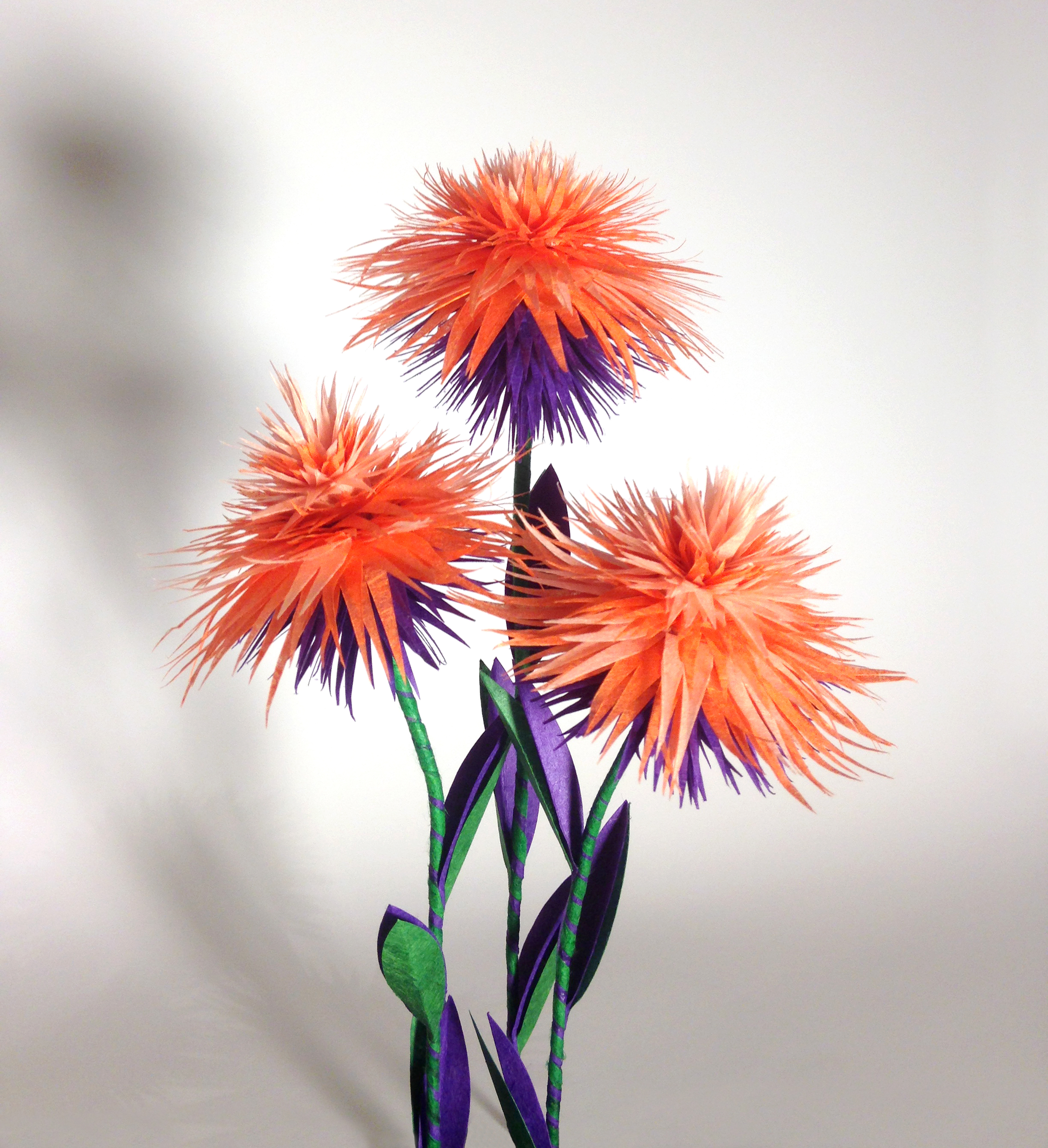From the collection of Hyacinth Pettibone, noted botanist and chiropterology enthusiast, her beloved pet bat Vlad is second only to her botanical pursuits. She has devoted her life to the study of plants and has a particular fascination for collecting carnivorous, poisonous, and rather nefarious flora. Included with these specimens from Hyacinth's collection are her notes regarding each onesunique characteristics.
Armored Pom Pom (Flore Loricatorum)
One of my absolute favorite flowers, they look ever so lovely dotted around one's grounds. However, care must be taken when pruning as contact with the pom poms will result in a rapidly spreading and exceedingly itchy rash that lasts for days. It's been quite a while since I've seen the neighbor children playing in my garden.
-H.P.
Black Widow Bloom (Nigrum Flosviduae)
This sweet-smelling carnivorous plant uses the aroma it produces to attract insects into its sticky center. The mosquitoes, flies and such become entangled in the web like poof and are then digested, creating the rouge coloration. I often have to hand feed this plant as Vlad will swoop in and eat the bugs before the plant can.
-H.P.
Blue Crab Claw (Cancrorum Ungula)
Blue Crab Claw is the main ingredient used to flavor Cerulean Siren; a distilled, slightly tart, and highly alcoholic beverage. Unlike absinthe, this deep blue spirit's psychoactive and hallucinogenic properties have not been exaggerated. Shortly after drinking Cerulean Siren, a friend of mine sauntered out of the party only to turn up three days later with no memory of the past thirty-six hours and in someone else's clothes.
-H.P.


Blushing Lance, Orange Variety (Rosea Spica)
A dainty perennial plant, the Blushing Lance adds a touch of elegance to any bouquet or arrangement. Unfortunately, some people can suffer serious allergic reactions when around this flower. My sister Violet swelled up like a balloon and broke out all over in hives. She really should have let me do her wedding flowers.
-H.P.
Crimson Snare (Floshabens Rostra)
A vibrant ornamental flower that also happens to be carnivorous. Generally known to devour insects that find their way into its jaws, the Crimson Snare prefers to feast on fingers, as a former assistant of mine found out.
-H.P.
Dragon Wing Ivy (Foliis Draco)
Dragon Wing Ivy derives its name from the wing like leaves that adorn the twisting climbing vines. Extremely fast moving and destructive, this plant is not to be confused with the begonias bearing the same moniker; doing so can have dire repercussions. My great uncle's tool shed was overtaken and toppled within hours.
-H.P.
Ghoulbane (Exspiravit Mors)
A rather fetching little blossom, few people choose to plant them due to their smell. Not harmful from a distance, should someone put their face up close, like one would to smell a rose, the odor can be so overpowering as to cause fainting. Regrettably, my mother-in-law did not heed my warnings. I don't keep these flowers by the koi pond anymore.
-H.P.
Ice Spikes (Spicis Glacies)
One of the only specimens in my collection that grows and thrives in the winter. I won it in a wager with my brother, the Commodore. He bet me that the Aubergine Recluse wasn’t dangerous, I maintained it was. He lost the prized Ice Spikes and most of the skin from his left hand that day.
-H.P.
Kraken Lotus (Polypus Vastator)
A tricky to house little water plant. If it makes its way to any sort of substantial body of water, a garden pond for example, the Kraken Lotus will grow to an unreasonably large size very quickly and its tentacle like leaves will strangle out and destroy anything nearby. I lost one of my favorite statuaries, a wedding present from my husband’s elderly aunt to this plant. I was devastated.
-H.P.
Medusa Coil (Caput Medusae)
Named after the mythological creature, the Medusa Coil is a charming and very hearty flower making it an ideal choice to use in flower arrangements. They can last in vases for months before they start to wither. Unlike their namesake, these flowers won't turn you to stone, however they will make one’s hands go completely numb and lifeless if gloves aren't worn while handling them. One of the senior librarians, a self-proclaimed expert in flower arranging, thought that the Medusa Coil bouquet I created to brighten up the foyer of the library needing improving. The poor dear couldn't catalog anything for over a week, bless her heart.
-H.P.
Midnight Ink Orchid, Blue Variety (Atramento Nocte)
This squid shaped orchid is a decidedly temperamental plant. If jostled, it will squirt out an inky fluid that not only stains horribly but will cause temporary blindness. Quite an unpleasant consequence for curious garden party guests that tend to wander. Luckily, we were able to get them all rides home.
-H.P.
Puppet Eyes (Venenum Oculus)
Puppet Eyes, so named for the white round berry with black centers, have eyelash like petals that surround the berries. Poison envelopes this plant; from the berry, to the petals, to the sap that leaches out of the stem. My neighbor, a rather vexing individual, insisted that if you cooked the berries, they were safe to eat. They're not. My new neighbor, however, is delightful.
-H.P.
Queens Mace, Dark Red Variety (Arma Reginae)
A particularly interesting thorny plant, most of a similar type have thorns on the stem but this one's are located in the middle of the florets. If not careful, someone could get a nasty prick should they get too close. If only my nephew would have played outside instead of in the conservatory.
-H.P.
Venus Orchid (Orchidaceae Venerem)
One of my own creations, a cross between Giant Fly Traps and a Viper Orchid. I am most pleased with the result. A colleague of mine from the institute, however, thought producing this sort of creature impossible, and insisted upon seeing it for himself. It was only during his inspection that we realized just how aggressive a carnivorous and venomous plant the Venus Orchid can be, once it latches on it won’t let go. The doctors did an excellent job, and I for one, think my colleague looks better with a smaller nose.
-H.P.
